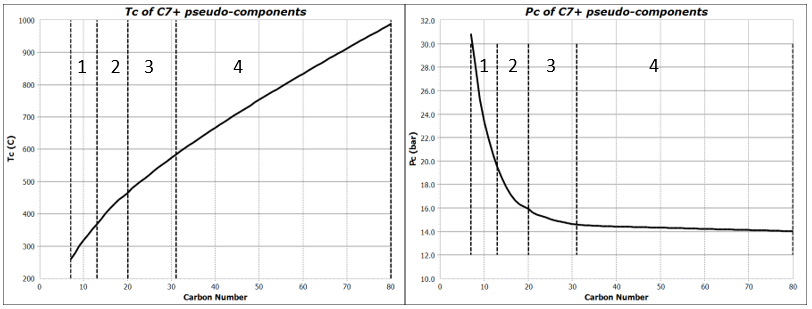Accurate fluid compositions are prerequisite to the development of reservoir fluid Equation of State (EoS) models; however, many studies have shown that compositions measured through GC have significant uncertainties in the amount of heavier carbon number fractions. In particular, the plus molecular weight and amount have a high degree of uncertainty, which can significantly impact the accuracy of saturation pressure predictions.
Uncertainty in Fluid Compositions
Table 1 provides an overview of findings from several recent studies that have shown that reservoir fluid compositional measurements can carry a significant degree of uncertainty. These uncertainties can stem from the representativeness of the collected sample, the gas-condensate ratio used for recombination, baseline shift during GC measurements, internal standards used during GC, and molecular weights of carbon fractions (Younus 2022, Schebetov 2010).
| Author | Observation |
| Stephen et al. 2008 | >50% relative deviation in C36+ wt % |
| Hustad et al. 2013 | 5 wt% difference in C30+ wt% obtained from TBP analysis vs. GC |
| Mawlod et al. 2021 | >30% relative deviation in C30+ wt% ≈8.8% relative deviation in MW |
| Meisingset et al. 2020 | ≈10% Uncertainty in C10+ MW |
| Younus et al. 2022 | Baseline shift errors in GC cause wt% uncertainties to increase with carbon number. Internal standard errors cause additional uncertainty in the plus amount. |
Characterization
PVTsim uses the Pedersen characterization method, which has been shown to predict saturation pressures within about 10% of the experimental value without tuning EoS parameters when an accurate composition for the reservoir fluid is provided (Pedersen et al. 1992).
The reservoir fluid characterization method employed by Pedersen et al. (1992) assumes an exponentially decaying molar distribution of carbon number fractions for the heavy end of the reservoir fluid. When plotting the logarithm of the mole fraction against carbon number for this distribution, the result is a straight line with a negative slope. To fully leverage the predictive capabilities of the Pedersen characterization procedure, it is highly important to utilize a representative extrapolation line.
This distribution function is constrained by material balance, which requires the extrapolated plus fraction to match both the weight percent and molecular weight of the measured plus fraction. This requirement means that errors in the plus fraction properties can significantly impact the extrapolation line. Figure 1 illustrates the effect of this uncertainty on both the extrapolation line and the resulting simulated phase envelope. If the measured plus molecular weight exceeds the true value, the extrapolation line will exhibit a flatter slope, leading to an overabundance of heavy carbon fractions in the composition. Consequently, this results in an excessively high simulated saturation pressure for gas condensates. Conversely, if the plus molecular weight is too low, the opposite effect occurs.

Optimal use of GC Compositions
Methodology
Watson et al. (2023) described a new methodology for optimal use of GC compositions. In brief, the methodology is:
- Perform a Quality Check on the fluid data
- Determine a fitting region of log-linear mole fractions (e.g. C10 – C25)
- Optimize the plus molecular weight to minimize the RSS of the extrapolation line as defined below:
- Lump the plus fraction back by 1 carbon number
- Repeat steps 3-4 until RSS is globally minimized
The procedure explores lumping the plus fraction to lower carbon numbers, and adjusts the C7+ molecular weight, in order to determine the optimal extrapolation line for the heavy end of the fluid.
Application and Results
Watson et al. (2023) applied this methodology to 45 fluids ranging from volatile oils to gas condensates. The results showed significant improvements in the prediction of saturation pressures without tuning. A portion of the results are shown in Figure 2 for fluids from the Eagle Ford Shale play. The results also showed that in all cases, log-linear composition extrapolation provides a good continuation of the measured data. The composition extrapolation lines from a small portion of the fluids, after the method was applied, are shown in Figure 3.


Summary
To take full advantage of the predictive capabilities of the Pedersen characterization method, it is necessary to use an accurate composition. By lumping back the plus fraction and making small adjustments to the C7+ molecular weight, the influence from uncertainties on the measured plus fraction amount and molecular weight is minimized. This leads to better predictions of the saturation pressure of the fluid.
References
Hustad, O.S., Jia, N.J., Pedersen, K.S., Memon, A., Leekumjorn, S., 2013. High Pressure Data and Modeling Results for Phase Behavior and Asphaltene Onsets of GoM Oil Mixed with Nitrogen. Presented at the SPE Annual Technical Conference and Exhibition, OnePetro. https://doi.org/10.2118/166097-MS
Mawlod, A., Memon, A., Nighswander, J., 2021. Accuracy and Precision of Reservoir Fluid Characterization Tests Through Blind Round-Robin Testing. Presented at the Abu Dhabi International Petroleum Exhibition & Conference, OnePetro. https://doi.org/10.2118/207749-MS
Meisingset, K.K., Cely, A., Bergo, C., Yang, T., 2020. When Can a Stock-Tank Oil be a Condensate? Presented at the SPE Norway Subsurface Conference, OnePetro. https://doi.org/10.2118/200759-MS
Pedersen, K.S., Blilie, A.L., Meisingset, K.K., 1992. PVT calculations on petroleum reservoir fluids using measured and estimated compositional data for the plus fraction. Ind. Eng. Chem. Res. 31, 1378–1384. https://doi.org/10.1021/ie00005a019
Schebetov, A., Rimoldi, A., Piana, M., 2010. Quality Check of Gas-Condensate Pvt Studies and Eos Modelling under Input Data Uncertainty. Presented at the SPE Russian Oil and Gas Conference and Exhibition, OnePetro. https://doi.org/10.2118/133258-MS
Stephen, A.G., Bergman, D., Dodd, T., Kriel, W., 2008. PVT Data Quality: Round Robin Results. Presented at the SPE Annual Technical Conference and Exhibition, OnePetro. https://doi.org/10.2118/116162-MS
Watson, C. D.; Mogensen, K.; Krejbjerg, K. A Novel Procedure for Addressing Compositional Uncertainty in Volatile Oils, Critical Fluids, and Gas Condensates; OnePetro, 2023. https://doi.org/10.2118/216783-MS.
Younus, B., Whitson, C.H., Martinsen, S., 2022. Compositional Uncertainties in Laboratory PVT Data. Presented at the ADIPEC, OnePetro. https://doi.org/10.2118/211391-MS



